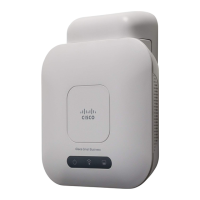Wireless
Radio
Cisco WAP571/E Administration Guide 72
5
through the system log and SNMP traps. Enter a time from 0 to 900 seconds. The
default is 300 seconds.
STEP 3 Select the Radio interface to configure (Radio 1 or Radio 2).
STEP 4 In the Basic Settings area, configure these settings:
NOTE Local regulations may prohibit the use of certain radio modes. Not all modes
are available in all countries.
• Radio—Turns on or off the radio interface. By default, the radio is on.
NOTE If you enable the 5 GHz radio with 80 MHz bandwidth and if the radio carries
a high amount of traffic, then the WAP device will need more power than what the
IEEE 802.3af PoE standard provides (12.95 W). It is highly recommended that when
80-MHz channel is in use, the WAP device should be powered by an 802.3at Power
Source Equipment (PSE). If the required power by the WAP device exceeds the
maximum power delivered by the PSE, then the WAP device may reboot.
• MAC Address—The Media Access Control (MAC) address for the interface.
The MAC address is assigned by the manufacturer and cannot be changed.
• Mode—The IEEE 802.11 standard and frequency the radio uses. The default
value of Mode is 802.11a/n/ac for Radio 1 and 802.11b/g/n for Radio 2. For
each radio, select one of the available modes.
Radio 1 supports the following radio modes:
- 802.11a—Only 802.11a clients can connect to the WAP device.
- 802.11a/n/ac—802.11a clients, 802.11n, and 802.11ac clients operating
in the 5-GHz frequency can connect to the WAP device.
- 802.11n/ac—802.11n clients and 802.11ac clients operating in the 5-GHz
frequency can connect to the WAP device
Radio 2 supports the following radio modes:
- 802.11b/g—802.11b and 802.11g clients can connect to the WAP device.
- 802.11b/g/n (default)—802.11b, 802.11g, and 802.11n clients operating
in the 2.4-GHz frequency can connect to the WAP device.
- 802.11n 2.4-GHz—Only 802.11n clients operating in the 2.4-GHz
frequency can connect to the WAP device.

